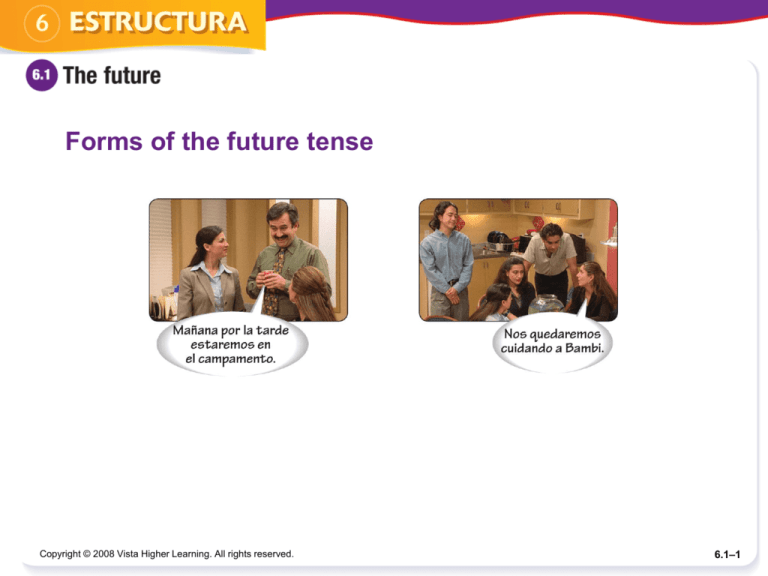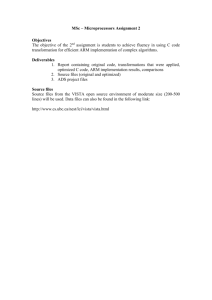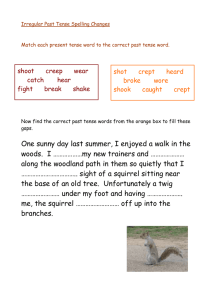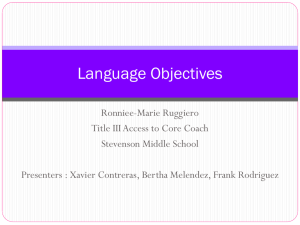
Forms of the future tense
Copyright © 2008 Vista Higher Learning. All rights reserved.
6.1–1
• The future tense (el futuro) uses the same endings
for all –ar, –er, and –ir verbs. For regular verbs, the
endings are added to the infinitive.
Copyright © 2008 Vista Higher Learning. All rights reserved.
6.1–2
• For irregular verbs, the same future endings are
added to the irregular stem.
Copyright © 2008 Vista Higher Learning. All rights reserved.
6.1–3
Note that all of the future tense endings carry a written accent
mark, except the nosotros/as form.
Copyright © 2008 Vista Higher Learning. All rights reserved.
6.1–4
Uses of the future tense
• In Spanish, as in English, the future tense is one of
many ways to express actions or conditions that will
happen in the future.
PRESENT INDICATIVE
PRESENT SUBJUNCTIVE
conveys a sense of certainty that
the action will occur
refers to an action that has yet
to occur: used after verbs of will
and influence.
Llegan a la costa mañana.
Prefiero que lleguen a la costa
mañana.
They arrive at the coast
tomorrow.
I prefer that they arrive at the
coast tomorrow.
Copyright © 2008 Vista Higher Learning. All rights reserved.
6.1–5
The future tense is used less frequently in Spanish than in English.
Te llamo mañana.
I’ll call you tomorrow.
Copyright © 2008 Vista Higher Learning. All rights reserved.
6.1–6
ir a + [infinitive]
FUTURE TENSE
expresses the near future;
is commonly used in
everyday speech
expresses an action that will
occur; often implies more
certainty than ir a + [infinitive]
Van a llegar a la costa mañana.
Llegarán a la costa mañana.
They are going to arrive at the
coast tomorrow.
They will arrive at the coast
tomorrow.
Copyright © 2008 Vista Higher Learning. All rights reserved.
6.1–7
• The English word will can refer either to future time
or to someone’s willingness to do something.
To express willingness, Spanish uses the verb
querer + [infinitive], not the future tense.
¿Quieres contribuir a la
protección del medio ambiente?
Quiero ayudar, pero no sé
por dónde empezar.
Will you contribute to the
protection of the environment?
I’m willing to help, but I don’t
know where to begin.
Copyright © 2008 Vista Higher Learning. All rights reserved.
6.1–8
• In Spanish, the future tense may be used to express
conjecture or probability, even about present events.
English expresses this sense in various ways, such
as wonder, bet, must be, may, might, and probably.
¿Qué hora será?
Ya serán las dos de la mañana.
I wonder what time it is.
It must be two a.m. by now.
¿Lloverá mañana?
Probablemente tendremos un poco
de sol y un poco de viento.
Do you think it will rain
tomorrow?
It’ll probably be sunny and windy.
Copyright © 2008 Vista Higher Learning. All rights reserved.
6.1–9
• When the present subjunctive follows a conjunction
of time like cuando, después (de) que, en cuanto,
hasta que, and tan pronto como, the future tense is
often used in the main clause of the sentence.
Nos quedaremos lejos de la costa hasta que pase el huracán.
We’ll stay far from the coast until the hurricane passes.
En cuanto termine de llover, regresaremos a casa.
As soon as it stops raining, we’ll go back home.
Copyright © 2008 Vista Higher Learning. All rights reserved.
6.1–10









